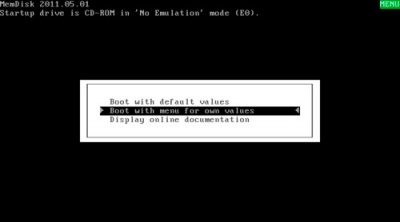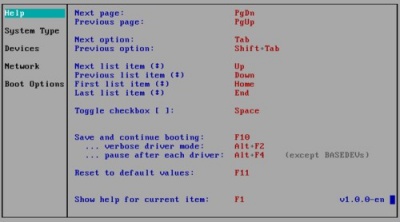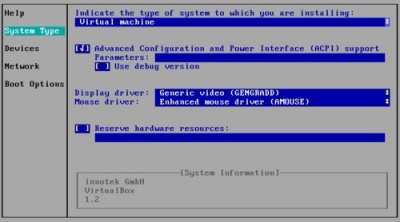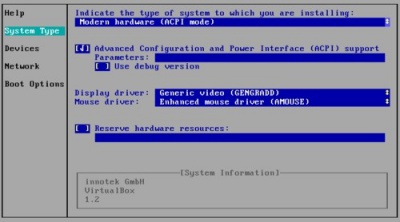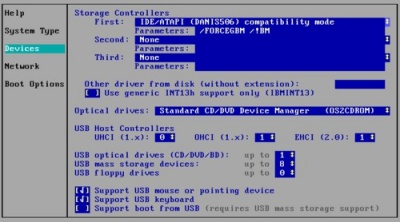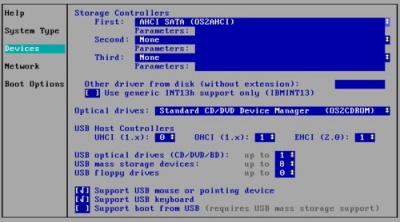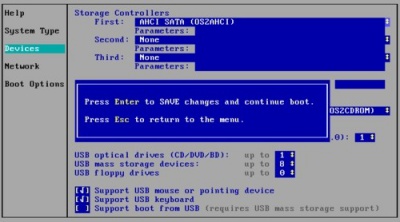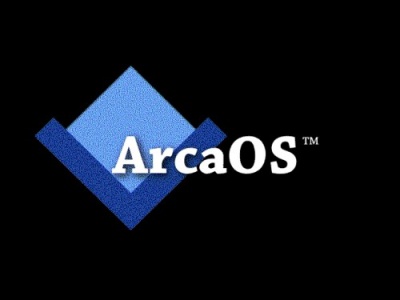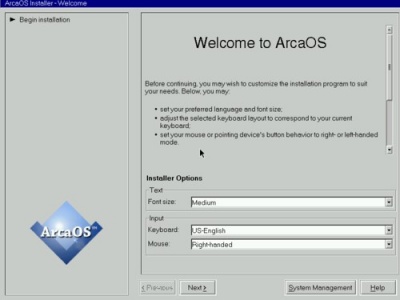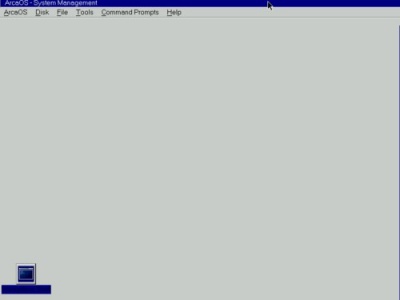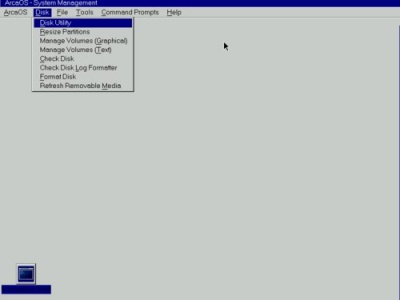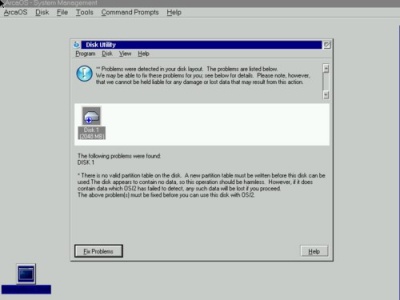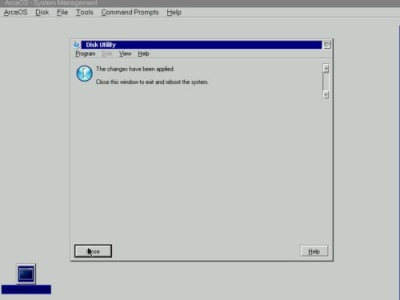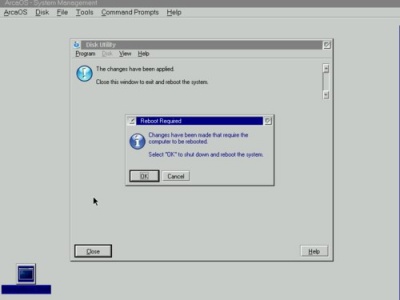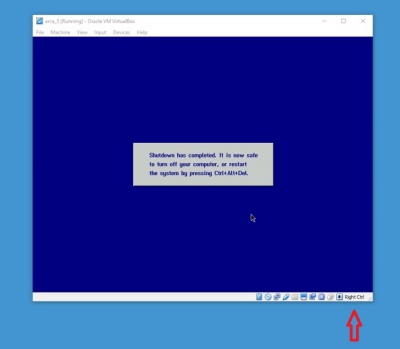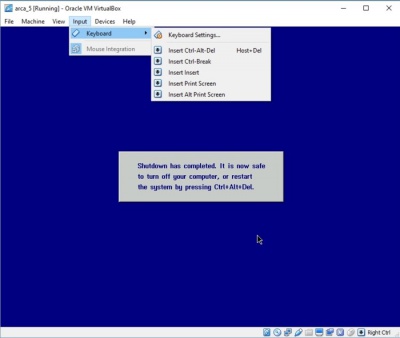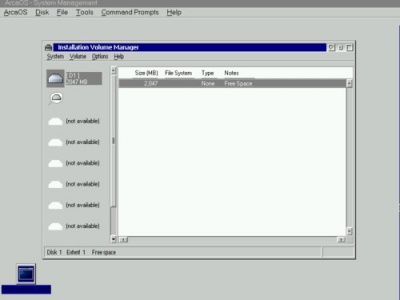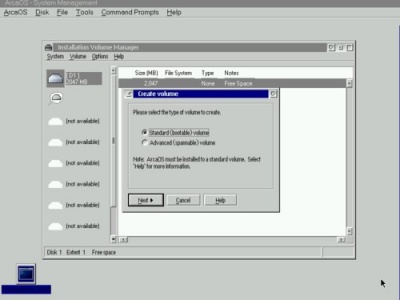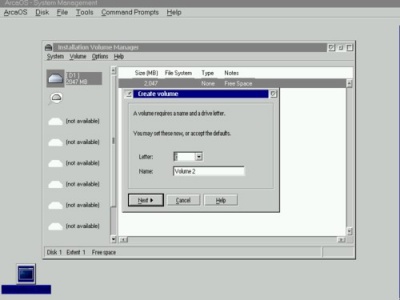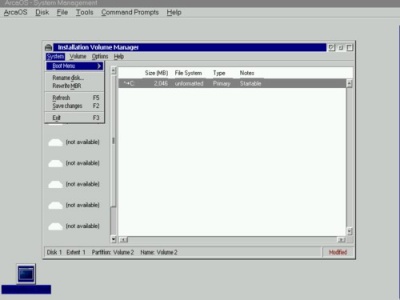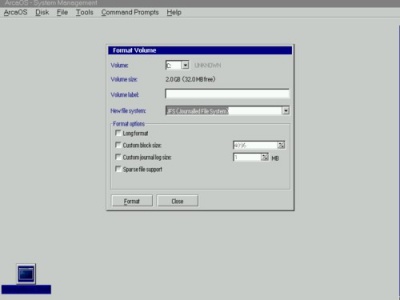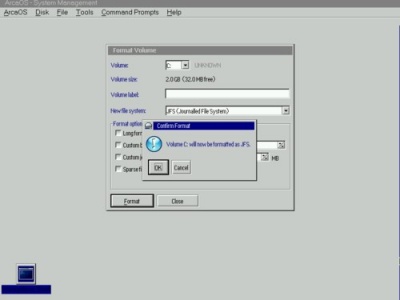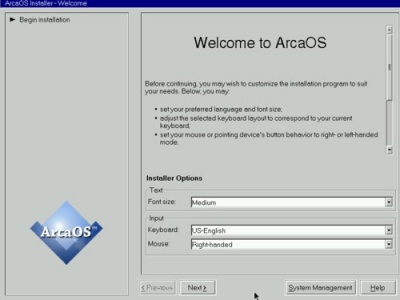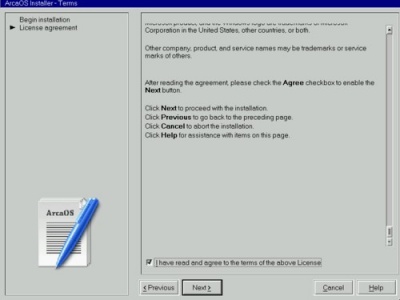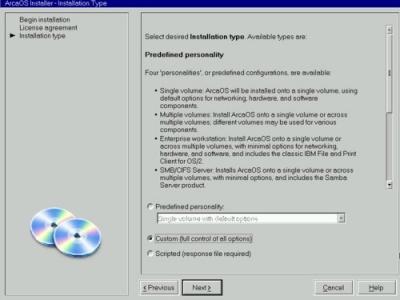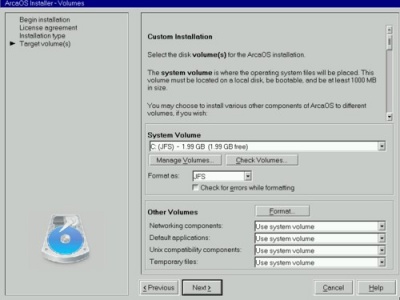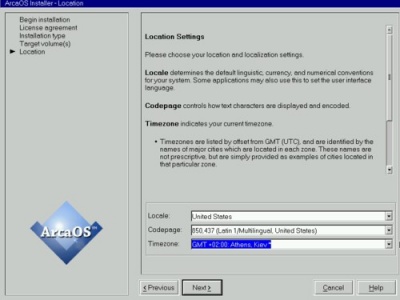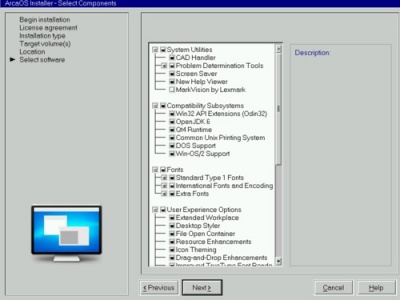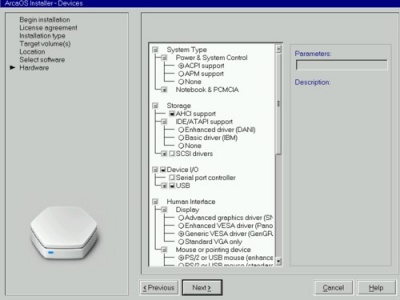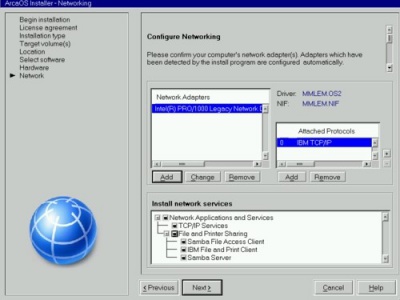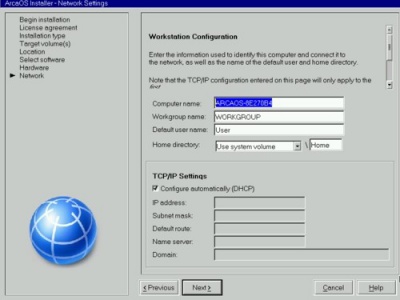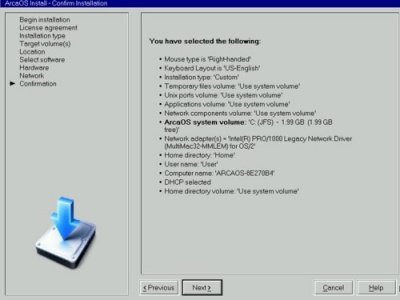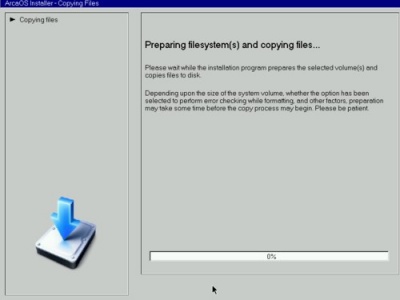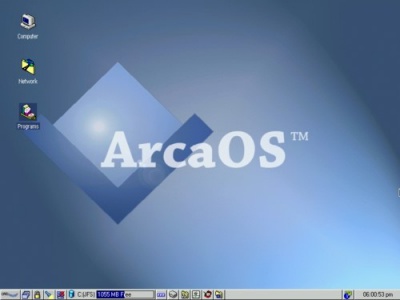Install ArcaOS 5.0 On VirtualBox With Multiprocessor Kernel
| Article Info | |
|---|---|
| Author | Richard Dunkle |
| Date | 2017-06 |
| OS Version | ArcaOS 5.0x |
| Companion File | N/A |
| Source | N/A |
This is a basic install of ArcaOS on VirtualBox. This install differs from the basic ArcaOS virtual machine install which only uses the uniprocessor kernel. This install will use the multiprocessor kernel. This install was tested on VirtualBox 5.1.22 for Windows 10 64bit and macOS Sierra. This install fails on Win10 32 bit as there is a bug on access of the SATA hard drive in VirtualBox.
Settings for VirtualBox
- Start the VirtualBox program
- Click New icon on toolbar
- Enter a name for your virtual machine
- Something like arca5 is fine
- Type: IBM OS/2
- Version: eComStation
- Next
- Memory Size: 1024MB is adequate
- Next
- Hard disk – radio button – Create a virtual hard disk now
- Click Create
- Hard disk file type: radio button - VDI
- Click Next
- Storage on physical hard disk: radio button -- Dynamically allocated
- Click Next
- File location and size: accept the default (2 GB)
- Click Create
- Basic settings are now complete
Additional customization needed:
- Select your virtual machine from the pane on the left
- Click Settings icon on toolbar
- From the left pane, Click System
- Radio button – enable I/O APIC
- Click page tab: Processor
If you want add extra processor for your virtual machine
- Click Enable PAE/NX (not sure if this is used or even needed)
- Acceleration page tab – leave on defaults
- Left pane menu – click Display
- Video memory – use slider to adjust to 64 MB (not sure what optimal setting should be)
- Left side menu – click Storage
- Center pane, right mouse click on: Controller IDE
- Click Remove controller
- Right mouse click in white space for Storage Tree
- Click Add SATA controller
- Click small hard drive icon to the right of the Controller SATA
- Click button – Choose existing disk
- Navigate the file menu to find the place where VirtualBox created the original disk image
This will usually be something like:
C:\Users\your_user_name\VirtualBox VMs\your_vm_name
- Select your disk image
- Click -- Open button
You will be back at the dialog with the Storage Tree
- Click small CD icon to the right of the Controller SATA
- Click -- Choose disk
- Navigate to location of your ArcaOS iso file that was unzipped from the file: ArcaOS-5.0.iso.7z
- Click radio button to enable Use Host I/O Cache
(forget this check and the disk may not be accessible to the ArcaOS Disk Utility)
Left side menu – Click Audio
- The defaults should work fine: Enable Audio | Windows Direct Sound | ICH AC97
Left side menu – Click Network
- There are some advanced option here that can confuse people.
I suggest the following:
- Enable Network adapter
- Attached to: Bridged adapter
- Name: accept the supplied default
- Click the arrow for Advanced
- Adapter type: Intel PRO/1000 MT Desktop (8254OEM)
- Promiscuous Mode: Deny
- MAC address: accept the generated default
Check on Cable Connected
You can leave the other options on the left menu alone: (Serial Ports, USB, Shared Folders, User Interface)
- Click OK
Your VirtualBox setting should now be complete
Installing the OS
You are now ready to start the install.
On the VirtualBox toolbar - Click the green Start arrow
Use arrow key to select Boot with menu for own values
- Press Enter key
You will see the navigation meu:
- Press the PageDown key on keyboard
You will see the System Type menu:
We will do a special install to allow for multiple processors. The default “Virtual machine” only installs the uniprocessor kernel
Press the Down Arrow key to cycle through the installs.
Now the navigation is a bit tricky.
Cycle through system types until you have Modern Hardware (ACPI mode).
Next we need to select devices. It is easy with the PageDown key
On Devices we need to select SATA OS2AHCI Again a bit tricky, using the Up Arrow and Down Arrow key on the keyboard
We are now ready to boot the ArcaOS CD Save our configuration press F10 on keyboard
Press Enter key to save changes and continue to boot.
You will see the ArcaOS splash screen and booting will continue.
Now the Welcome to ArcaOS screen:
Let’s get right to setting up the hard drive.
Click on the System Management button, to get to the utilities.
Click on the Disk menu choice
Since our disk is a new unused disk we need the let ArcaOS write some LVM information.
Click on button Fix Problems.
The changes have been applied. Now we need to reboot.
- Click on the button Close.
The dialog will appear to tell us a reboot is required.
Click on the button OK.
The virtual machine is ready to restart. How to send a Control Alt Delete to a virtual machine may not be readily apparent. You need to hit the special Host key, which is the Right Control key on the Windows version of VirtualBox
Depending on what host operating system you use the Host button can be different. To see what the Host button really is look at the lower left corner of the VirtualBox window.
Press the VirtualBox Host key and then the mouse will be free from inside the VirtualBox.
Then select the menu Input from the top of the VirtualBox window.
- Now click on Insert Ctrl-Alt-Del.
The CD will boot again.
- Use the arrow key to choose: Boot with menu for own values.
We need to set up the values again for machine and device type.
Then again make the choices for:
- System Type: Modern hardware (ACPI mode)
- Devices: AHCI SATA (OS2AHCI)
- Press F10 to save settings
- Press Enter and system reboots
You will be back at the Welcome to ArcaOS screen.
- Click button System Management
- Click Disk | Manage Volumes (Graphical)
- On the Installation Volume Manager, Click Volume | Create New.
- Accept the default – Standard (bootable) volume.
- Click Next
Make sure this shows the Drive letter: C.
You can accept the defaults Name: Volume2.
- Create Volume dialog.
- Accept the defaults, make sure it shows 2047MB, that is your C drive.
- Click button Finish.
- Click System | Save Changes | Exit.
- Save changes dialog.
- Click button Yes.
This should take you back to the System Management Menu.
- Click Disk | Format Disk.
- Format Volume dialog.
Make sure the drive letter is C and the new filesystem is JFS (Journaled File System).
- Click button Format.
Confirm Format dialog.
- Click button OK.
Format will take only seconds.
- On the success dialog Click button OK.
This will take you back to the Format Volume dialog.
- Click button Close.
The hard drive is now ready for the install of ArcaOS.
- On the menu Click ArcaOS.
- Click menu Restart the Installer.
This will bring back the Welcome to ArcaOS screen.
Make selection for Font size, Keyboard, and Mouse.
- Click button Next.
This will bring up the License Agreement. Read the agreement and scroll to the bottom and if you agree,
- Click the check box then click button Next
Next screen is the Installation type.
- Make selection and click button Next.
I prefer the Custom (full control of all options).
Custom Installation screen
Accept the defaults unless you have some special needs.
- Click the button Next
Note: Do not worry about the Format we already did that step.
Location screen
Make any adjustments for language or time zone as needed.
Select Components screen
Make any adjustments as needed.
- Then click button Next.
Devices screen
The defaults will be fine. Make any adjustments as needed for your situation. The sound driver is even correct. Universal Audio Driver.
Networking screen
Make any adjustments to File and Printer sharing as needed.
- Click button Next.
Workstation configuration
Adjust any settings as needed Some people may want to change the computer name or workgroup name. The defaults are fine for most people. Note it is a little difficult to change the Computer Name later on, it requires hand edit of a system file. Furthermore this document shows a DHCP network connection. Adjust the IP address information if you use a static address.
Confirm Installation screen. Check for any mistakes.
- Click button Next.
The installation starts to copy files.
There will be two reboots and copying files will all be automatic. When complete you will hear the startup music from ArcaOS and see your desktop.
